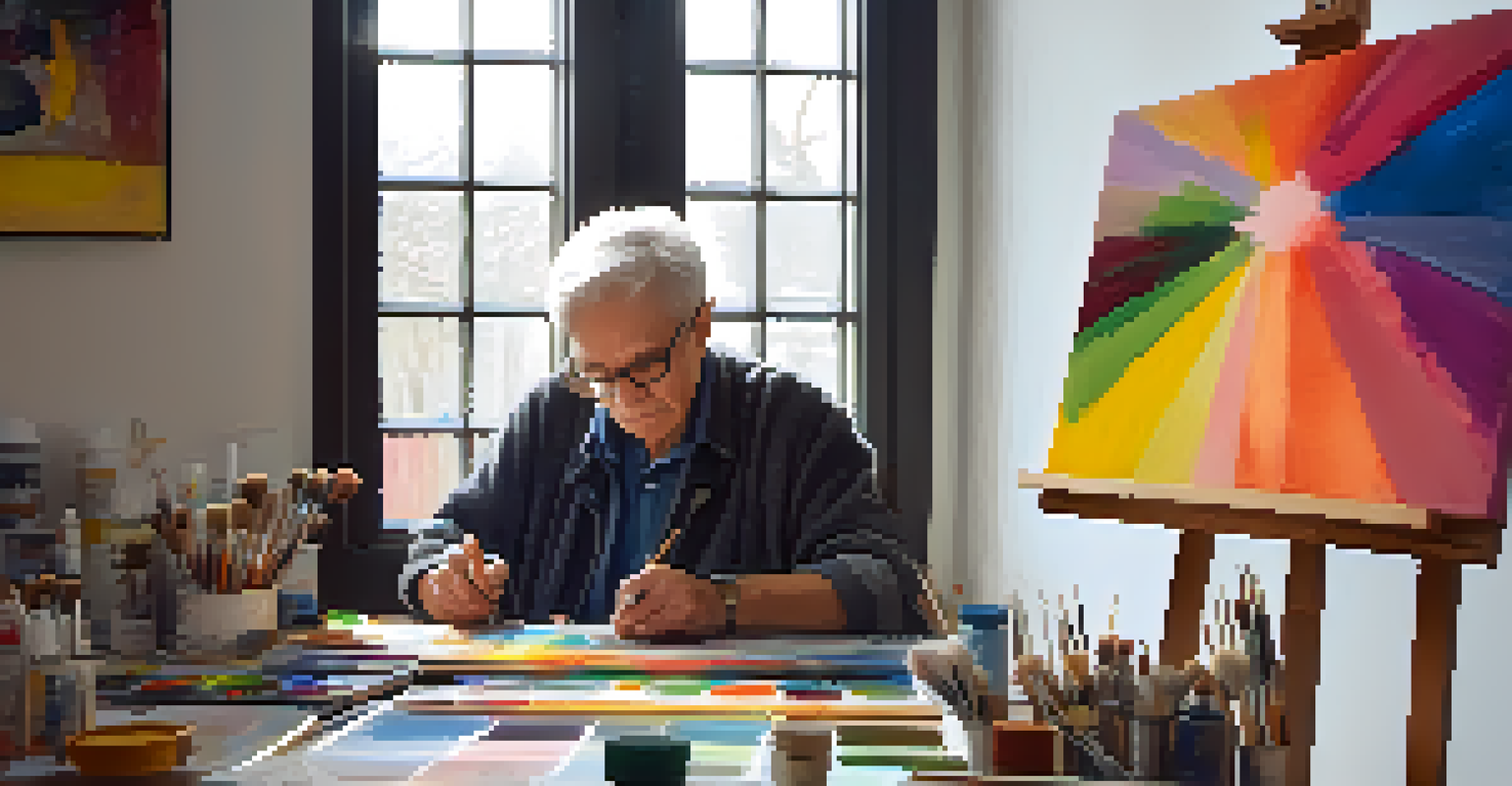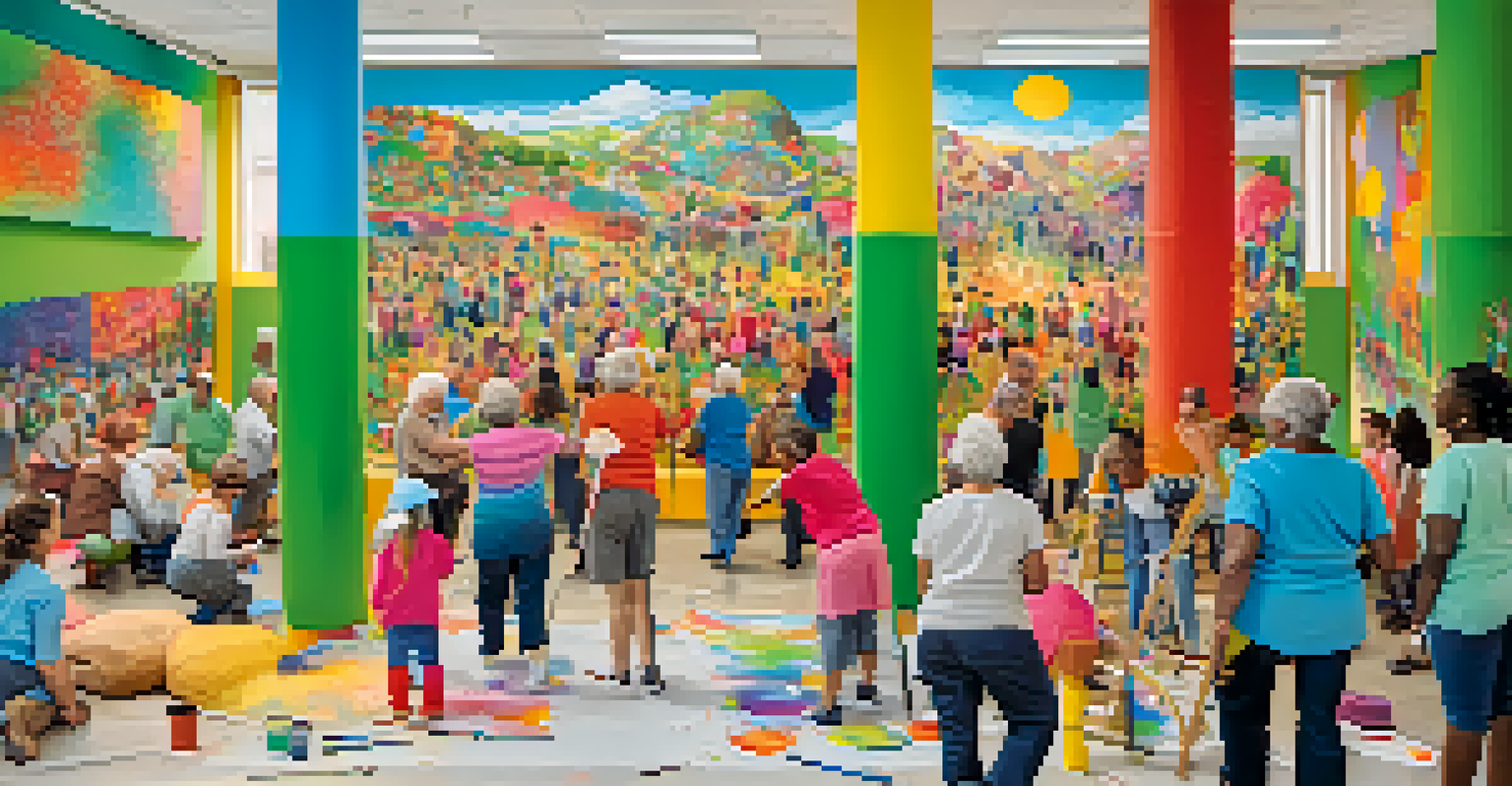Art and Aging: Representations of the Human Life Cycle

The Role of Art in Understanding Aging and Life Cycles
Art has long served as a mirror reflecting the human experience, including the complexities of aging. Through various mediums, artists explore themes of life stages, showcasing how aging is not just a physical process but a rich tapestry of experiences. By representing different ages, artists invite viewers to reflect on their own life journeys and the universal nature of aging.
Art enables us to find ourselves and lose ourselves at the same time.
For instance, paintings depicting the elderly often highlight wisdom and resilience, encouraging a deeper appreciation for the aging process. Artists like Rembrandt have famously portrayed older subjects with dignity, reminding us that each wrinkle tells a story. This representation can shift societal perceptions, pushing against the stereotype of aging as merely decline.
Moreover, the emotional connection that art fosters allows for a broader dialogue about aging. Through exhibitions or community art projects, people of all ages can engage with the themes of aging, creating a space for shared experiences and understanding.
Historical Perspectives: How Art Depicts Aging Over Time
Throughout history, art has evolved alongside societal attitudes towards aging. In ancient cultures, the elderly were often revered as bearers of wisdom, reflected in sculptures and pottery. For example, the Greeks celebrated aging in their art, portraying older figures as dignified and respected members of society.

As time progressed, particularly during the Renaissance, artists began to explore the more nuanced aspects of aging. Works by artists like Leonardo da Vinci captured the complexity of human emotions related to aging, showcasing both beauty and vulnerability. This shift reflects changing societal values and the growing recognition of the elderly's place in society.
Art Reflects Aging's Complex Journey
Artists use various mediums to explore aging as a rich tapestry of experiences, inviting viewers to reflect on their own life journeys.
Today, contemporary art continues to challenge and redefine how we view aging. Artists are now more likely to present aging as a vibrant and integral part of life, using innovative techniques to engage viewers in conversations about age, identity, and experience.
Modern Art Movements and Their Take on Aging
In the 20th century, various art movements began to focus on the human condition, including aging. Movements like Expressionism and Surrealism offered new ways to explore the emotional and psychological aspects of aging. Artists would often use distorted forms and abstract imagery to convey the feelings associated with growing older.
The more I paint, the more I realize that aging is a privilege, and a beautiful one at that.
For instance, artists like Egon Schiele used raw and expressive lines to portray the struggles of aging, highlighting the tension between physical decay and inner vitality. This artistic exploration allows viewers to confront the realities of aging, rather than shy away from them.
Moreover, contemporary art often incorporates multimedia elements that emphasize aging's multifaceted nature. Installations and performances can evoke the sensory realities of aging, inviting audiences to engage with the topic in a visceral way.
Personal Narratives: Artists' Experiences with Aging
Many artists draw from their personal experiences with aging, creating works that resonate on a deeply human level. These narratives often capture the nuances of growing older, from the joys to the challenges. For instance, artist Frida Kahlo used her own physical struggles and aging process to inform her artwork, creating pieces that reflect both pain and strength.
Such personal storytelling in art allows for a more intimate connection between the artist and the audience. When viewers can relate to the artist's experiences, the art becomes a shared space for reflection and understanding.
Historical Views Shape Aging Perception
Art has evolved through history, reflecting changing societal attitudes towards aging, from reverence in ancient cultures to nuanced portrayals in modern times.
Furthermore, these narratives can inspire others to embrace their own aging process, fostering acceptance and appreciation for life's transitions. Artists become storytellers, forging connections through their lived experiences.
The Impact of Aging on Artistic Expression
As artists age, their perspectives and techniques often evolve, influencing their creative output. Many find that their work becomes more introspective, reflecting a deeper understanding of life and mortality. This evolution can lead to a more authentic expression of self, as they draw from their experiences over the years.
Moreover, aging artists may feel a sense of urgency to share their stories, leading to a prolific period of creativity. The wisdom gained through years of experience often translates into powerful art that resonates with both younger and older audiences.
The intersection of aging and creativity highlights the idea that art can continue to thrive at any age. It challenges the notion that artistic talent diminishes with time, showcasing instead how life experiences can enrich artistic expression.
Community Engagement: Art as a Tool for Aging Awareness
Art can play a vital role in raising awareness about aging within communities. Workshops, exhibitions, and collaborative projects can bring together individuals of all ages to explore themes of aging through creativity. This engagement fosters understanding and empathy, breaking down barriers between generations.
For example, community art projects that involve older adults can create a platform for sharing stories and experiences. These initiatives not only celebrate the creativity of older individuals but also challenge stereotypes about aging, showing that life remains vibrant and meaningful.
Technology Enhances Art and Aging Dialogue
Advancements in technology, such as virtual reality and digital art, open new avenues for engaging audiences in meaningful conversations about aging.
Additionally, art can be used in educational settings to teach younger generations about the aging process. By engaging with art that reflects aging, young people can gain insights into the realities of growing older, promoting a culture of respect and appreciation for the elderly.
Future Directions: The Role of Technology in Art and Aging
As technology continues to advance, it opens up new avenues for artists to explore aging in their work. Digital art, virtual reality, and interactive installations can create immersive experiences that engage audiences in unique ways. These innovative practices offer fresh perspectives on the aging process, making it more relatable to a tech-savvy generation.
For instance, virtual reality experiences can simulate the physical and emotional aspects of aging, allowing participants to walk in the shoes of older adults. This technology can foster empathy and understanding, making the conversation around aging more accessible.

Furthermore, online platforms enable artists to share their work with a global audience, sparking dialogues about aging across cultures. As we look to the future, the intersection of technology and art will likely play a significant role in shaping how we perceive and represent aging.